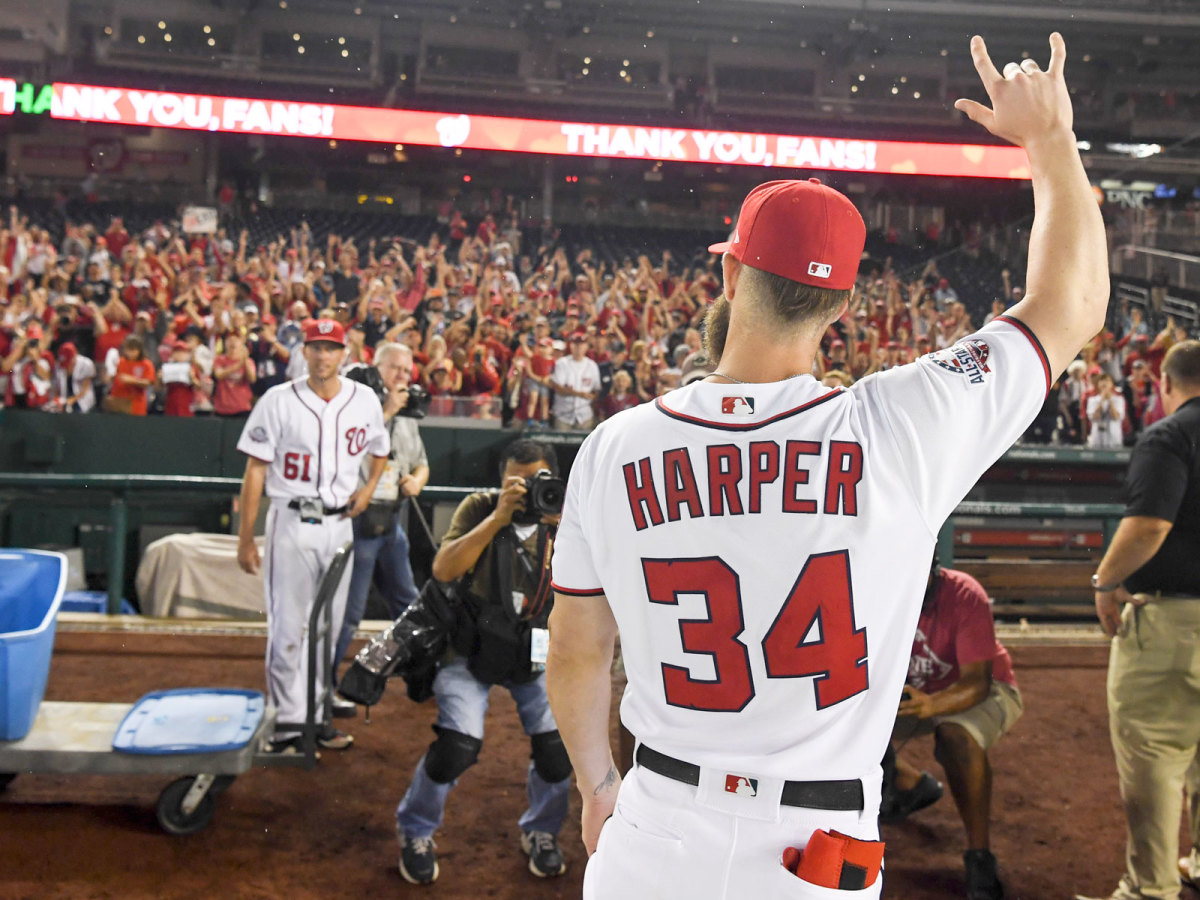Ten Years After His Rise to Fame, Bryce Harper Sits Squarely in the Spotlight as a Free Agent

Enmity is the downside to being one of the most famous and hyped baseball players in the world. I once asked Bryce Harper what it was like bearing the contempt and derision from those turned off by his renown.
“I love the way people talk crap,” he said. “I hear it all the time. ‘Overrated. You suck.’ I’ll just do something to shut them up. Like, ‘I’ll show you.’”
He was 16 years old at the time. Sixteen. A high school sophomore.
This world of his, a world of hyper-criticism that never allows the luxury of quietude, is the only world Harper ever has known. At 10, he was jumping on planes as a hired gun for travel ball tournaments. At 15, he was hitting home runs in front of scouts at the Area Code Games. At 16, he was on the cover of SI. At 17, he was the first overall pick in the draft. At 19, he was in the big leagues. Now at 26, he is the most expensive asset to ever hit the free agent market.
Everything in his young life has been geared for this moment of putting his prime years up for auction, including back to when his family and his agent, Scott Boras, crafted the plan to get him out of high school after just two years (obtaining a GED) and into a junior college to make him draft-eligible in 2010. Of course, he was rebuked for making that choice, because … well, who does he think he is?
A double-bass player like Edicson Ruiz, at age 17 in 2003, can be celebrated for becoming the second youngest member of the famed Berlin Philharmonic Orchestra, which has been around since 1882. But a baseball prodigy bucking the system at Harper’s age? Tsk, tsk.
VAULT:Tom Verducci's Cover Story on 16-Year-Old Bryce Harper (With Bonus Annotations)
The decision seems even more prescient now that baseball teams value youth over experience. Getting Harper on the market at 26 instead of 27 makes it even more likely he will set a record when it comes to money spent on a player.
When the Washington Nationals made Harper a 10-year, $300-million offer at the end of this season, it was the most extravagant window dressing since Fifth Avenue at Christmas. Both sides knew it was done out of obligation with no chance of being accepted.
Boras is so full of creative statistical accounting on behalf of his clients— remember his comparison between Oliver Perez and Sandy Koufax?—it’s too easy to dismiss what he says about Harper as more hyperbole. But he is right when he calls Harper a generational talent, even if Harper has a high-maintenance swing and that his defense last season suffered from being miscast in centerfield and from getting wall-shy to preserve his health.
What he has by the boatload are the most valued assets in today’s game: youth, power, the ability to get on base, and transcendent commercial star power that is rare in baseball.
There is no arguing that he is on a Hall of Fame trajectory. Only 11 other players hit more home runs through their age-25 season than Harper. Nine are in the Hall of Fame or going in (Mel Ott, Jimmie Foxx, Mickey Mantle, Eddie Mathews, Frank Robinson, Orlando Cepeda, Ken Griffey Jr., Albert Pujols and Mike Trout) and two are not, either because of steroid use (Alex Rodriguez) or a lapsed work ethic (Andruw Jones).
Only nine others reached base more often than Harper through age 25. Only three others took more walks. At this age Harper is a near statistical twin of Griffey, another generational talent:
Through Age 25 Season

These special players just don’t get on the free agent market at this age. The only comparison is Rodriguez, Harper’s closest comp in terms of leverage, who 18 years ago became the highest paid player by 48% on average annual value and by 108% in total money.
That’s why the Nationals’ 10-year, $300-million offer had no chance. Harper is either going to break the record for highest annual value ($34.4 million that went to a 32-year-old free agent pitcher, Zack Greinke) or most guaranteed money ($325 million in a 13-year extension to Giancarlo Stanton, without the leverage of free agency) or both.
When Texas signed Rodriguez, Boras said, “You really had to have a plan to bring in this kind of player, a plan almost a year in advance.”
The Dodgers, Yankees and Giants all reset their competitive balance tax rate a year in advance of this free agent market. The Phillies and White Sox are traveling upward on the winning curve and have cleared payroll for a franchise player. The Cardinals, Astros and Twins could be stealth suitors. The Nationals remain in it—maybe even as the favorite.
“I think he has to go back to Washington,” scoffed one veteran executive. “He sucks the air out of a room.”
That’s an old-school view, a way of saying Harper is too much of an outsized personality to make others around him better, similar to how then-Mets GM Steve Phillips said signing Rodriguez would have transformed the Mets into a “24-plus-one” roster.
Harper is the embodiment of how baseball changed in this generation. Born of the burgeoning travel ball culture, he played more games per year as a pre-teen than minor league professionals, hopping from team to team. He shortened baseball’s long learning curve with so many reps, but he also grew the streak of individualism that travel ball fosters. The goal is to be seen, to climb prospect lists, to ace the measureables at showcases—to slather eye black around your face like a 70s rocker so you stand out.
Social media and ubiquitous video mean youthful mistakes are shared, not hidden. He was 18 years old and playing in the backwoods of Class A ball when he blew a kiss at a pitcher after hitting a home run. Of course, cameras were there specifically because he is Bryce Harper and it became one of the most talked-about Class A home runs ever. More than half a million people viewed it on YouTube.
(The opponents had knocked Harper from the game the previous day by hitting him with a pitch because they thought he was too famous. But those factors never fit the narrative of “this kid is too cocky.”)

The next phase of Harper’s career will be to learn how to win. It’s not that he did not want to win in Washington, but neither he nor the team knew how to do it. The past seven years, during which the Nationals never got out of the postseason's first round, seemed to be played with a countdown clock above Harper’s head—the countdown to free agency.
Harper never came close to signing an extension all these years with Washington, the way Trout did with the Angels, Clayton Kershaw did with the Dodgers and Félix Hernández did with the Mariners. He was bound for free agency from the day he stepped on a major league field and everybody knew it.
Last year, I asked Harper when he had the most fun playing baseball. His answer surprised me. He went back to 2009 when he was 16 years old and playing for the USA Baseball 18U team that won the Pan American Junior Championships in Barquisimeto, Venezuela. Cuba had won seven straight championships before USA beat Cuba twice to win the gold medal.
Jameson Taillon, now with the Pirates, pitched the championship game with relief help from Kevin Gausman, now of the Braves. Harper was their catcher. The shortstop was Manny Machado. Three USA players made the all-tournament team: Harper, who was still only 16, Machado, and Brian Ragira, who played five years of minor league ball, two of them in independent ball.
“Team USA,” Harper told me about his most fun in baseball, “because you’re playing for your country. You’re playing for something bigger than yourself with that name ‘USA’ on the front, and hearing the national anthem blaring over the speakers in a foreign country and kicking the crap out of that team in a foreign country. There is no greater feeling. We were able to play Cuba and beat Cuba. Jorge Soler was on that team. Actually, he hit an 0-0 changeup against Robbie Ray to the moon.”
Yet, Harper never played for the USA in the World Baseball Classic. Boras said it was about protecting his “routine.” In Washington, he enjoyed the support there, but without a championship.
Roundtable:Will the Yankees Pursue Bryce Harper?
“When you’re able to know a city is behind you,” he said, “and they’re going to show up every single night to support you, that momentum, that peace of mind—‘We love you no matter what’—that’s a good feeling.
“I love playing on the road. I love going into all the other ballparks and playing because it makes coming back home to DC that much better. I’m able to come home and get a standing O. I’m not going to get a standing O anywhere else.”
Imagine playing every game since you were a teenager under as much enmity as admiration. There are times, Harper admitted in our conversation last year, when it gets to him.
“Only when they talk about my family,” he said.
Harper grew up with a framed poster of Mickey Mantle in his bedroom. He wore the Mick’s number 7 on youth teams until he joined a travel team at age 10 and the number already was taken, so he took 34 (3+4=7). He collects baseball jerseys, owning those of Willie Mays, Stan Musial, Derek Jeter, Mariano Rivera and Robinson Cano, to name a few. He seems aware of baseball history, but was never a big enough fan to watch much of the World Series when he was a kid.
“You’re going to laugh,” he said. “I enjoy sports history but I never really watched the World Series. The most memorable moment in my head from watching it growing up was Aaron Boone hitting the home run off Wakefield, off the knuckleball [in the 2003 ALCS]. I saw it all the time. If I look [back] at a moment, it was that one. I never watched the Red Sox series in ’04. I didn’t look at it. I was like 10, 11 years old.”
His wife, Kayla, and his parents get on him about not saving mementos from his career. His 2015 MVP Award is with his parents. He said he doesn’t know where is the ball from his first major league hit.
Last year Bryce and Kayla hired an interior decorator for their home. Kayla sent Bryce a snapshot of a collection of pictures the decorator designed for a wall in their living room.

“One of the pictures said something about baseball,” Harper said. “One out of a whole collage of pictures. Kayla sent it to me and said, ‘What do you think?’ I go, ‘We need to take down that baseball picture. I don’t want to go home and think about baseball.’”
For the first time—and in a moment that’s been in the works in the decade since he took his GED test—Harper is now able to determine his value on the open market. As happens with free agents, much will be written and debated about his flaws, not his strengths. He never has driven in more than 100 runs—this year finally getting exactly to 100, long a personal goal of his. He struck out at a career-worst rate this year (24.3%) with a career-low contact rate (68.6%). He is a .211 career postseason hitter with a 25.8 percent whiff rate.
Remember, though, that in 2015 Harper had an all-time great season, becoming only the sixth player to lead the league with at least 42 homers and a .460 OBP. (The others: Barry Bonds, Mark McGwire, Ted Williams, Lou Gehrig and Babe Ruth.) The next year he banged his right shoulder sliding into a base in Milwaukee in June and played more than half the season in so much pain he could not do any upper body weight training. After starting the season at 230 pounds, he ended it at 195, the lightest he had been since his rookie season at age 19 ground him down to 185. His numbers cratered.
REITER:Ranking Harper, Machado and the Top 50 Free Agents
After a winter of recovery and training, he started 2017 back at 230 pounds and was on his way to joining Johnny Bench as the only players to win two MVP awards before age 25. But in August he hyperextended his knee when he slipped on a wet base, missed five weeks and was rusty when he came back in late September.
This year he hit .214 in the first half—a scenario that exposed what happens when his high-maintenance swing goes off kilter even a smidge—but recovered with a .300/.434/.538 second half, all better than his career rates.
If there is any worry about how Harper ages, it is in how that swing holds up in the back of a contact covering 10 years or more. He hits with ferocious, whip-like athletic movements to the baseball—the kind of fast-twitch movements that are impressive now but can decline with age. And because he hits with so much head and body movement, Harper is prone to pulling off pitches. This year, for instance, he hit only .200 on fastballs away. Like Ryan Howard, he has been much worse in his career late in games (.239 from the seventh through ninth innings; .295 before) because teams can neutralize him with relievers who throw lefthanded or feature velocity away. (Howard was .220 in the late innings, .275 before).
To his credit, this year Harper tried to temper his swing with two strikes. Sometimes he would ditch his leg kick and simply place his front foot down on his toes and wait for the pitch. Still, he hit .151 with two strikes, a career low.
Keep in mind, too, that Harper, like so many lefthanded power hitters, has been harmed by the proliferation of highly-calibrated defensive shifts. Over the past three years shifts against Harper have tripled, costing him 51 points off his batting average on balls in play up the middle and pulled:
Effect of Shifts vs. Harper

If commissioner Rob Manfred bans or limits shifts any time soon, that’s good news for Harper.
Maybe all you need to know about how to judge Harper as a 26-year-old free agent is the statement made by opposing pitchers this year. In a season in which Harper hit .214 through the first 96 games and whiffed a career-high 169 times, they challenged him less than any hitter in baseball. The average hitter sees 51% of pitches out of the zone. Fearing Harper, pitchers threw him 59% pitches out of the zone, the most in the majors.

Almost a decade ago, I found a 16-year-old kid who was in love with playing baseball and competing, who knew he was extremely talented and dared to be great. Back then I compared him to LeBron James not because he was as great in baseball as James was in basketball, but because like James, he had professional skills as a high schooler. That rarely happens in baseball, a game of precise skills. Harper was so good so early that if he were allowed into the major league draft as a sophomore he would have been picked first or second in the estimation of some club executives.
I watched him play high school games, went to dinner with him and his parents and saw how tightly knit was the Harper family. What struck me was how prepared he seemed to be to take on the baseball world, both physically and emotionally.
When I asked him about his goals, he said in a strong, firm voice without hesitation, “Be in the Hall of Fame, definitely. Play in Yankee Stadium. Play in the pinstripes. Be considered the greatest player who ever lived. I can’t wait.”
He was 16 years old, and if you can’t dream when you are 16, if you can’t see the world as an opportunity to be what you wish, then what are dreams even for?
At 26, as reality starts to scrub some of the shimmer off our dreams, Harper has reached a crossroads in his very public baseball life. Like Rodriguez, he is likely to sign with whatever team offers him the most money. It will be the culmination of at least a decade not just of hard work, but also of establishing his value.
Once he signs, and assuming the deal covers 10 years or more, Harper no longer has to concern himself with value and the factors that make it so. As a rare free agent this young and this good, he will get the answer that has been so long in the making. And when that happens, he can just go play baseball.
Because he’s Bryce Harper, he will never know that luxury of quietude, to go unnoticed no matter the results. But he can play with having earned the one big score, and the peace that comes from a long-term commitment. And that allows him to better chase the feeling he has been chasing since he was 16 and playing in Venezuela: to be a champion, the most fun anybody can have on a baseball field.
